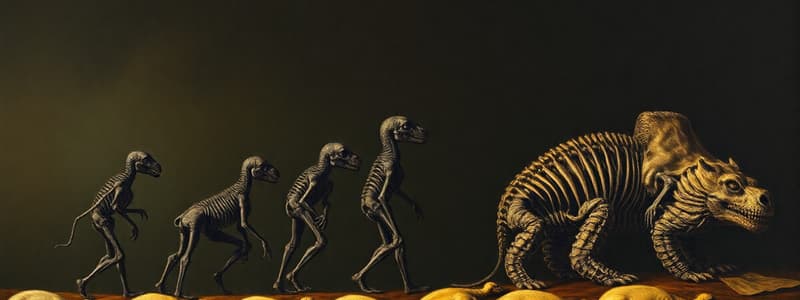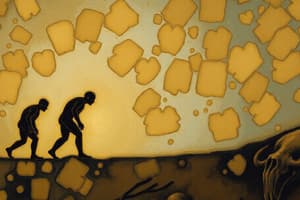Podcast
Questions and Answers
What is the main premise of Darwin and Wallace's theory of evolution through natural selection?
What is the main premise of Darwin and Wallace's theory of evolution through natural selection?
- Organisms that are better adapted to their environment tend to survive and reproduce. (correct)
- All species evolve at the same rate regardless of their environment.
- Species change only in response to environmental disasters.
- Natural selection only occurs in artificial settings, such as farms.
Which of the following best describes homology in evolutionary biology?
Which of the following best describes homology in evolutionary biology?
- The modifications in traits that arise due to individual experiences.
- The concept that unrelated species develop similar traits due to similar environmental conditions.
- The similarity between species due to shared ancestry. (correct)
- The evolutionary process leading to the extinction of certain species.
What role do vestigial structures play in evolutionary theory?
What role do vestigial structures play in evolutionary theory?
- They are recent adaptations that have replaced ancestral traits.
- They are adaptations necessary for modern survival.
- They illustrate evolutionary relationships and common ancestry. (correct)
- They are fundamental features that dictate the survival of a species.
How is genetic variation important for natural selection?
How is genetic variation important for natural selection?
Which of the following describes the Hardy-Weinberg equilibrium?
Which of the following describes the Hardy-Weinberg equilibrium?
What is meant by convergent evolution?
What is meant by convergent evolution?
What key factor allows artificial selection to occur?
What key factor allows artificial selection to occur?
Which of the following is NOT a factor that contributes to genetic variation in populations?
Which of the following is NOT a factor that contributes to genetic variation in populations?
What is the primary consequence of genetic drift in small populations?
What is the primary consequence of genetic drift in small populations?
Which type of natural selection favors both extreme traits?
Which type of natural selection favors both extreme traits?
Which of the following best describes the process of speciation?
Which of the following best describes the process of speciation?
What defines the Biological Species Concept?
What defines the Biological Species Concept?
Which of the following mechanisms can lead to reproductive isolation?
Which of the following mechanisms can lead to reproductive isolation?
What is an example of sympatric speciation?
What is an example of sympatric speciation?
Which of the following best describes the term 'fitness' in an evolutionary context?
Which of the following best describes the term 'fitness' in an evolutionary context?
What is the primary significance of the bottleneck effect?
What is the primary significance of the bottleneck effect?
How does horizontal gene transfer complicate the construction of phylogenetic trees?
How does horizontal gene transfer complicate the construction of phylogenetic trees?
Which of the following statements about natural selection is true?
Which of the following statements about natural selection is true?
What do molecular clocks use to estimate the divergence time of species?
What do molecular clocks use to estimate the divergence time of species?
Which type of selection maintains multiple forms in a population?
Which type of selection maintains multiple forms in a population?
What is the primary characteristic of eukaryotic cells?
What is the primary characteristic of eukaryotic cells?
What phenomenon is described by the term 'adaptive radiation'?
What phenomenon is described by the term 'adaptive radiation'?
Flashcards
Natural Selection
Natural Selection
The process where organisms better adapted to their environment survive and reproduce.
Descent with Modification
Descent with Modification
The process where species evolve over time, passing traits with changes to offspring.
Fossil Record
Fossil Record
Evidence showing the progression of life forms over geological time.
Homology
Homology
Signup and view all the flashcards
Biogeography
Biogeography
Signup and view all the flashcards
Convergent Evolution
Convergent Evolution
Signup and view all the flashcards
Hardy-Weinberg Equilibrium
Hardy-Weinberg Equilibrium
Signup and view all the flashcards
Genetic Variation
Genetic Variation
Signup and view all the flashcards
Hardy-Weinberg Conditions
Hardy-Weinberg Conditions
Signup and view all the flashcards
Directional Selection
Directional Selection
Signup and view all the flashcards
Stabilizing Selection
Stabilizing Selection
Signup and view all the flashcards
Genetic Drift
Genetic Drift
Signup and view all the flashcards
Speciation
Speciation
Signup and view all the flashcards
Allopatric Speciation
Allopatric Speciation
Signup and view all the flashcards
Sympatric Speciation
Sympatric Speciation
Signup and view all the flashcards
Gene Flow
Gene Flow
Signup and view all the flashcards
Fitness
Fitness
Signup and view all the flashcards
Adaptive Radiation
Adaptive Radiation
Signup and view all the flashcards
Phylogenetic Trees
Phylogenetic Trees
Signup and view all the flashcards
Monophyletic Groups
Monophyletic Groups
Signup and view all the flashcards
Molecular Clocks
Molecular Clocks
Signup and view all the flashcards
Reproductive Isolation
Reproductive Isolation
Signup and view all the flashcards
Hybrid Zone
Hybrid Zone
Signup and view all the flashcards
Study Notes
Descent with Modification (Chapter 22)
- Darwin and Wallace independently proposed the theory of evolution by natural selection.
- Organisms better adapted to their environment survive and reproduce more successfully, passing on advantageous traits.
- This theory builds on earlier ideas like Lamarck's theory of acquired traits.
- Supported by evidence from the fossil record, biogeography, anatomy, and direct observations of natural and artificial selection.
- Natural selection favors individuals with advantageous traits, leading to changes in traits over generations.
Evidence for Evolution
-
Fossil Record: Shows progression of life forms over time.
-
Biogeography: Species distribution patterns reflect evolutionary history.
-
Convergent Evolution: Different species evolve similar traits due to similar environmental pressures (e.g., wings in bats and birds).
-
Homologies: Similar structures in different species indicate a shared ancestry.
-
Mechanism of Natural Selection: Favorable traits lead to greater survival and reproduction, passing these traits to offspring.
Key Definitions (Chapter 22)
- Descent with Modification: Species evolve over time, inheriting traits with modifications.
- Homology: Similarity due to shared ancestry.
- Homologous Structure: Similar structures in different species due to shared ancestry.
- Analogous Structure: Similar structures due to convergent evolution, not ancestry.
- Convergent Evolution: Evolution of similar traits in unrelated species.
- Vestigial Structure: Structures that have lost their original function.
- Evolutionary Tree: Diagram showing evolutionary relationships.
- Biogeography: The study of species distribution.
- Artificial Selection: Humans selecting for desired traits.
- Adaptation: Trait that improves survival.
- Evolution: Change in a population's genetic composition over time.
Evolution of Populations (Chapter 23)
-
Smallest Unit of Evolution: Populations, where genetic changes are passed to subsequent generations.
-
Genetic Variation: Necessary for natural selection to act. Arises from mutations, gene flow, genetic recombination, and sexual reproduction.
-
Hardy-Weinberg Equilibrium: A non-evolving population. Used to calculate and predict allele and genotype frequencies.
-
Hardy-Weinberg Conditions: No mutation, random mating, no natural selection, large population size, and no gene flow. Real populations rarely meet these conditions.
Patterns of Natural Selection
-
Directional Selection: Favors one extreme trait.
-
Disruptive Selection: Favors both extremes.
-
Stabilizing Selection: Favors the average trait.
-
Balancing Selection: Maintains multiple traits in a population (e.g., heterozygote advantage).
-
Sexual Selection: Natural selection based on traits related to mating success.
- Intrasexual Selection: Competition between the same sex.
- Intersexual Selection: Mate choice by the opposite sex.
-
Natural Selection Not Goal-Oriented: Evolution doesn't aim for perfection. It adapts organisms to their environment using available genetic variation.
-
Genetic Drift in Small Populations: Chance events can significantly alter allele frequencies (bottleneck & founder effects).
Origin of Species and Macroevolution (Chapter 24)
-
Species Definitions:
- Biological Species Concept: Groups of interbreeding populations producing fertile offspring.
- Morphological Species Concept: Based on physical traits.
- Ecological Species Concept: Based on ecological niche.
-
Reproductive Isolation: Prevents gene flow between populations, resulting in divergence and speciation.
-
Mechanisms of Reproductive Isolation: Temporal, behavioral, mechanical, and gametic isolation prevent gene flow.
-
Sympatric Speciation: Speciation without geographic separation.
-
Allopatric Speciation: Speciation due to geographic isolation (most common).
-
Speciation: Formation of new species.
-
Reproductive Isolation: Mechanisms preventing interbreeding.
History of Life on Earth (Chapter 25)
- Eukaryotic Cells: Likely evolved from prokaryotes by endosymbiosis.
- Fossil Record Biases: Fossilization is rare, biased towards hard-bodied organisms.
- Steps in the Evolution of Life: From simple molecules to self-replicating molecules, prokaryotes, eukaryotes, multicellular life, etc.
- Age of Earth and Key Events:
- 4.5 billion years old
- Prokaryotes appeared ~3.5 billion years ago
- Eukaryotes appeared ~2 billion years ago
- Multicellular organisms appeared ~1 billion years ago
- Animals and land plants appeared ~500 million years ago
- Humans appeared ~200,000 years ago
- Environmental Changes: Volcanic eruptions, asteroid impacts, and climate shifts have driven evolutionary changes.
- Radiometric Dating: Estimating fossil ages by measuring isotopic decay.
- First Living Cells: Likely originated in Earth's oceans.
- Gene Expression and Pattern Formation: Genes (like Hox genes) dictate body structure during development.
- Early Development: Embryological similarities identify evolutionary relationships.
Phylogeny and the Tree of Life (Chapter 26)
- Phylogenetic Trees: Diagrams showing species' evolutionary relationships (based on morphological or genetic data).
- Revised Phylogenies: Trees are continually refined as new data emerges.
- Monophyletic Groups: Represent a common ancestor and all its descendants (preferred in taxonomy).
- Principle of Parsimony: Simplest explanations with the fewest evolutionary changes are preferred.
- Neutral Mutations: Mutations with no impact on fitness can spread by genetic drift.
- Molecular Clocks: Use mutation rates to estimate species divergence times.
- Horizontal Gene Transfer: Can complicate phylogenetic trees by transferring genes between species.
- Binomial Nomenclature & Taxonomy: Naming system and hierarchical system (domain, kingdom, etc.).
- Phylogeny: Evolutionary history of a species.
- Systematics: Study of biological diversity and evolutionary relationships.
- Taxon: Group of organisms.
- Clade: Group of an ancestor and all its descendants.
- Sister Taxa: Closely related groups.
- Analogies: Similarities due to convergent evolution.
- Homoplasy: Similar traits due to convergent evolution, not shared ancestry.
- Shared Ancestral Character: Trait inherited from a common ancestor.
- Shared Derived Character: Trait that evolved in the most recent common ancestor.
Studying That Suits You
Use AI to generate personalized quizzes and flashcards to suit your learning preferences.




